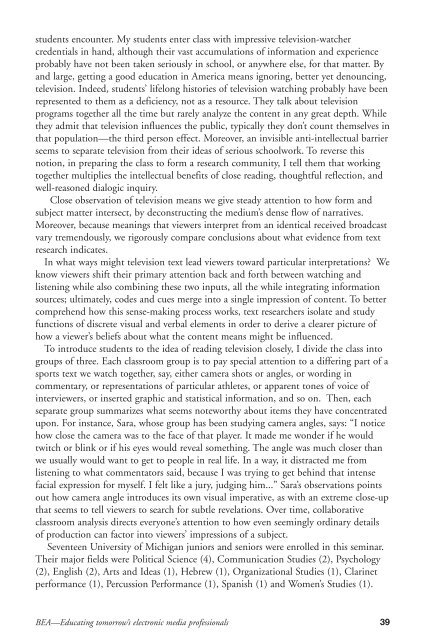Feedback November 2002 (Vol 43 No 4)
Feedback November 2002 (Vol. 43, No. 4) - Broadcast Education ...
Feedback November 2002 (Vol. 43, No. 4) - Broadcast Education ...
Create successful ePaper yourself
Turn your PDF publications into a flip-book with our unique Google optimized e-Paper software.
students encounter. My students enter class with impressive television-watchercredentials in hand, although their vast accumulations of information and experienceprobably have not been taken seriously in school, or anywhere else, for that matter. Byand large, getting a good education in America means ignoring, better yet denouncing,television. Indeed, students’ lifelong histories of television watching probably have beenrepresented to them as a deficiency, not as a resource. They talk about televisionprograms together all the time but rarely analyze the content in any great depth. Whilethey admit that television influences the public, typically they don’t count themselves inthat population—the third person effect. Moreover, an invisible anti-intellectual barrierseems to separate television from their ideas of serious schoolwork. To reverse thisnotion, in preparing the class to form a research community, I tell them that workingtogether multiplies the intellectual benefits of close reading, thoughtful reflection, andwell-reasoned dialogic inquiry.Close observation of television means we give steady attention to how form andsubject matter intersect, by deconstructing the medium’s dense flow of narratives.Moreover, because meanings that viewers interpret from an identical received broadcastvary tremendously, we rigorously compare conclusions about what evidence from textresearch indicates.In what ways might television text lead viewers toward particular interpretations? Weknow viewers shift their primary attention back and forth between watching andlistening while also combining these two inputs, all the while integrating informationsources; ultimately, codes and cues merge into a single impression of content. To bettercomprehend how this sense-making process works, text researchers isolate and studyfunctions of discrete visual and verbal elements in order to derive a clearer picture ofhow a viewer’s beliefs about what the content means might be influenced.To introduce students to the idea of reading television closely, I divide the class intogroups of three. Each classroom group is to pay special attention to a differing part of asports text we watch together, say, either camera shots or angles, or wording incommentary, or representations of particular athletes, or apparent tones of voice ofinterviewers, or inserted graphic and statistical information, and so on. Then, eachseparate group summarizes what seems noteworthy about items they have concentratedupon. For instance, Sara, whose group has been studying camera angles, says: “I noticehow close the camera was to the face of that player. It made me wonder if he wouldtwitch or blink or if his eyes would reveal something. The angle was much closer thanwe usually would want to get to people in real life. In a way, it distracted me fromlistening to what commentators said, because I was trying to get behind that intensefacial expression for myself. I felt like a jury, judging him...” Sara’s observations pointsout how camera angle introduces its own visual imperative, as with an extreme close-upthat seems to tell viewers to search for subtle revelations. Over time, collaborativeclassroom analysis directs everyone’s attention to how even seemingly ordinary detailsof production can factor into viewers’ impressions of a subject.Seventeen University of Michigan juniors and seniors were enrolled in this seminar.Their major fields were Political Science (4), Communication Studies (2), Psychology(2), English (2), Arts and Ideas (1), Hebrew (1), Organizational Studies (1), Clarinetperformance (1), Percussion Performance (1), Spanish (1) and Women’s Studies (1).BEA—Educating tomorrow’s electronic media professionals 39
















